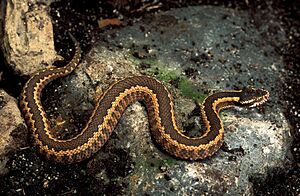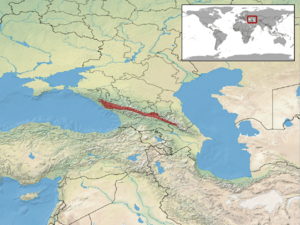Vipera dinniki facts for kids
Quick facts for kids Vipera dinniki |
|
|---|---|
 |
|
| Conservation status | |
| Scientific classification | |
| Genus: |
Vipera
|
| Species: |
dinniki
|
 |
|
| Synonyms | |
|
|
The Dinnik's viper (also known as the Caucasus subalpine viper) is a type of viper species found in the Caucasus Mountains. This area includes parts of Russia, Georgia, and Azerbaijan. Like all other vipers, it is a venomous animal. This means it can inject venom if it feels threatened. Currently, scientists do not recognize any different types (subspecies) of Dinnik's viper.
Contents
What's in a Name?
The scientific name, dinniki, was chosen to honor a Russian expert on reptiles and amphibians. His name was species:Nikolai Yakovlevich Dinnik.
How Big Are They?
Scientists have studied many Dinnik's vipers to learn about their size. The longest male viper found was about 41.2 centimeters (16.2 inches) long. The longest female viper was a bit bigger, measuring about 48.6 centimeters (19.1 inches) long. This length includes both the body and the tail.
Where Do Dinnik's Vipers Live?
You can find Dinnik's vipers in the Caucasus Mountains. They live in Russia, Georgia (especially near the Inguri River), and Azerbaijan. They prefer high mountain areas.
What Kind of Place Do They Like?
Dinnik's vipers like to live in several different natural places. Their favorite habitats include forests, areas with lots of shrubs, grasslands, and rocky spots. They are usually found at high altitudes, between 1,500 and 2,800 meters (about 4,900 to 9,200 feet) above sea level.
Reproduction
Dinnik's vipers are viviparous. This means that the mother gives birth to live young, instead of laying eggs. Mating usually happens in April and May. The baby vipers are born later, in August and September. A mother viper typically has 3 to 7 newborns in one group.
Conservation Status
The Dinnik's viper is currently classified as a vulnerable species by the IUCN. This means that its population is at risk. The main reasons for this classification are that the areas where they live are becoming smaller and more broken up. Also, their habitat quality is declining, and the number of vipers is expected to keep going down.


